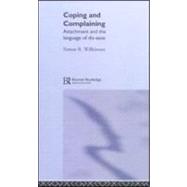
Note: Supplemental materials are not guaranteed with Rental or Used book purchases.
Purchase Benefits
Looking to rent a book? Rent Coping and Complaining: Attachment and the Language of Disease [ISBN: 9781583911693] for the semester, quarter, and short term or search our site for other textbooks by Wilkinson,Simon R.. Renting a textbook can save you up to 90% from the cost of buying.
| List of boxes | xi | ||||
| Preface | xiii | ||||
| Acknowledgements | xvi | ||||
| List of abbreviations | xvii | ||||
| 1 'I'm ill; you're sick' | 1 | (19) | |||
|
5 | (1) | |||
|
6 | (1) | |||
|
7 | (2) | |||
|
9 | (1) | |||
|
10 | (1) | |||
|
11 | (2) | |||
|
13 | (3) | |||
|
16 | (2) | |||
|
18 | (2) | |||
| 2 Genes, brain and the internal milieu: Our limits and resources | 20 | (32) | |||
|
21 | (2) | |||
|
23 | (5) | |||
|
28 | (9) | |||
|
37 | (3) | |||
|
40 | (4) | |||
|
44 | (2) | |||
|
46 | (1) | |||
|
47 | (5) | |||
| 3 Learning and memory: A basis for understanding development and change in the face of threat and danger | 52 | (37) | |||
|
53 | (14) | |||
|
67 | (5) | |||
|
72 | (13) | |||
|
85 | (1) | |||
|
86 | (3) | |||
| 4 The ideal patient: The 'balanced' type B attachment strategies | 89 | (29) | |||
|
92 | (6) | |||
|
98 | (10) | |||
|
108 | (5) | |||
|
113 | (2) | |||
|
115 | (3) | |||
| 5 'I'm OK; don't worry about me. The 'dismissing' type A attachment strategies | 118 | (46) | |||
|
119 | (17) | |||
|
136 | (4) | |||
|
140 | (9) | |||
|
149 | (11) | |||
|
160 | (3) | |||
|
163 | (1) | |||
| 6 'My pain is really terrible. What are you going to do about it?': The 'preoccupied' type C attachment strategies, and other classifications | 164 | (48) | |||
|
166 | (28) | |||
|
194 | (3) | |||
|
197 | (2) | |||
|
199 | (6) | |||
|
205 | (4) | |||
|
209 | (3) | |||
| 7 Ambiguous symptoms and the attachment strategies of health professionals | 212 | (34) | |||
|
216 | (14) | |||
|
230 | (11) | |||
|
241 | (5) | |||
| 8 Goal-corrected partnerships for health | 246 | (37) | |||
|
247 | (5) | |||
|
252 | (16) | |||
|
268 | (3) | |||
|
271 | (6) | |||
|
277 | (6) | |||
| Glossary | 283 | (4) | |||
| References | 287 | (26) | |||
| Index | 313 |
The New copy of this book will include any supplemental materials advertised. Please check the title of the book to determine if it should include any access cards, study guides, lab manuals, CDs, etc.
The Used, Rental and eBook copies of this book are not guaranteed to include any supplemental materials. Typically, only the book itself is included. This is true even if the title states it includes any access cards, study guides, lab manuals, CDs, etc.